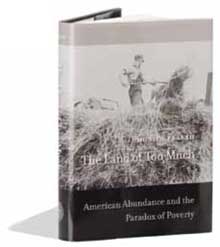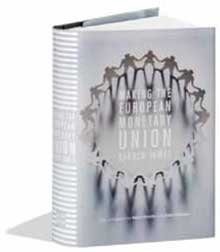Book Reviews
Finance & Development, December 2012, Vol. 49, No. 4
Credit-Welfare Trade-off
Monica Prasad
The Land of Too Much: American Abundance and the Paradox of Poverty
Harvard University Press, Cambridge, Massachusetts, 2012, 344 pp., $39.95 (cloth).

Easy credit has been the U.S. alternative to a welfare state. The United States has more poverty and a less-developed welfare state than western Europe because it chose between the 1890s and 1930s to promote consumption-driven economic growth made possible by easily available credit. So argues Monica Prasad, a Northwestern University sociologist, in her compelling new book.
Prasad presents interlocking arguments about credit, taxation, consumption, regulation, welfare state development, interest-group politics, overproduction, and poverty in explicating the past 120 years of U.S. economic history and how it differs from that of continental Europe. She asserts that the United States is not the laissez-faire market economy of political lore; it has a strong interventionist history characterized by more regulation and more-progressive taxation than France, Germany, or Scandinavia.
Whereas Europeans, particularly since World War II, constructed elaborate welfare states that provided universal health care, generous public pensions and social insurance, and redistributive social spending, the United States has used regulatory and tax policy to stimulate consumption and economic growth. The flip side of this trade-off between credit and welfare, according to Prasad, is that European countries restrained wage growth and consumption to facilitate higher investment in social spending, while the United States developed a more rudimentary welfare state that has left more of its population poor.
Prasad traces these differences to late 19th and early 20th century agricultural overproduction that led to bouts of deflation and the concurrent growth of large industrial enterprises. This galvanized agrarian reformers such as the Populists and their successors to advocate for regulation and a progressive income tax system, rather than more regressive but more efficient consumption taxes. The course of reform in the United States between the 1890s and 1930s, from William Jennings Bryan to Huey Long and Franklin Roosevelt, becomes the story of democratizing credit so much that mid-20th century U.S. growth was propelled by what Prasad calls “mortgage Keynesianism.”
Historians such as Lizabeth Cohen and Meg Jacobs have argued that U.S. policymakers from Franklin Roosevelt to Richard Nixon devoted themselves to increasing mass purchasing power and consumption to spur growth and raise living standards. The role of easy credit—from federal housing and college loan programs to private sector innovations such as installment buying and credit cards—in U.S. prosperity is also well known.
Prasad’s achievement is that she takes these arguments farther. First, she convincingly demonstrates that the United States went well beyond other countries in regulating the market—from food safety to banking—to protect consumers and foster consumption. Second, she makes the case that government went to great lengths to facilitate private borrowing for home ownership, college, and other consumption—from the Federal Housing Authority’s institutionalizing low-down-payment long-term mortgages to tax policy that made mortgage interest (and, for a while, other types of interest) tax deductible. Third, she says that a political coalition of Democrats and farm-state Republicans led the United States, in the 1920s and 1930s, to develop a progressive income tax rather than a national sales tax, which would have dampened consumption.
Prasad’s history leapfrogs from the early New Deal to the 1970s, when economic stagnation led both Republicans and Democrats to deregulate finance to make credit even more available. At this point, we come to the familiar tale of Americans taking on too much debt, leading to speculative bubbles and the 2008 financial meltdown.
History is where Prasad’s book runs into problems. She fails to address the fact that the U.S. economy boomed during the period of extensive welfare-state development—from the Social Security Act through the Great Society. And her argument that regressive taxation contributes to flourishing European social welfare states raises questions about why the shift toward less-progressive taxes in the United States since 1981 has ushered in not growth but scaling back in U.S. public benefits.
Prasad also assigns too much influence to the Populists and early 20th century agrarians, and conflates these very different movements with those of urban Progressive and New Deal reformers. While the United States has been an outlier in developing credit to promote consumption, as the author says, government policy has not been the only driver. Innovative business leaders, including department store magnates and Henry Ford, shrewdly saw the value of extending credit to customers, and working-class movements did much to spur the democratization of credit through the creation of building and loan associations and credit unions.
Moreover, Prasad’s argument about poverty, while provocative, is not well developed, and she glosses over questions of distribution. Prasad asserts that “progressive interventions backfired,” but the regulatory interventions of the Progressive and New Deal eras were not intended to reduce poverty. The extension of credit may have served as an alternative to welfare, but it too was intended to fuel growth, not alleviate poverty. In addition, although European welfare states have more successfully used social spending to reduce poverty and inequality, America’s steep progressive income tax in the 1950s and 1960s and the more recent Earned Income Tax Credit have reduced poverty and inequality through their redistributive effects.
It is unclear how applicable Prasad’s thesis is to developing economies whose welfare states, regulation, and credit are typically weak. Brazil and China have followed periods of rapid growth and poverty reduction with expanded social welfare programs, but the jury is out as to whether they will be as successful as Scandinavia or the United States in lifting their people out of poverty.
The book is occasionally repetitive, and the author makes several odd assertions. For example, she says that France created the “neoliberal financial architecture of the 1990s,” that the U.S. labor movement opposed a national sales tax for “pro-capitalist” reasons, and that the U.S. Affordable Care Act has achieved “universal health insurance.”
Nonetheless, many of Prasad’s arguments about the trade-off between credit and welfare and about the effects of the U.S. strong regulatory state and its progressive tax policies (until recent decades) are elegant and thought provoking. Although it lacks policy recommendations, this book certainly will stimulate debate over ways developed economies can provide that rare trifecta of growth, social justice, and economic stability.
Raymond Offenheiser
President, Oxfam America
Monetary Bliss: Bringing Currencies Together
Harold James
Making the European Monetary Union
Belknap Press, Cambridge, Massachusetts, 2012, 592 pp., $35.00 (cloth).

Princeton History Professor Harold James’s Making the European Monetary Union combines a concise historical narrative of the events leading up to the European Monetary Union (EMU) with a thought-provoking account of its origin, performance, and problems. This in-depth history will appeal to academic readers looking for extensive details about the EMU.
This fascinating and well-written book couldn’t be timelier. Well organized, thorough, and filled with historical facts, it explores the EMU’s political and economic roots.
When almost 10 years of relative ease for the EMU’s single currency came to an abrupt end with the start of the Greek debt crisis in 2010, the debate over the euro’s sustainability quickly turned to the question of whether there can be a monetary union without some sort of fiscal union.
According to James, Europe’s financial crisis cannot be blamed on the euro. The current crisis goes deeper, to a series of problems that were debated but not resolved at the time of the euro’s creation.
The origins of the eurozone crisis are explained in this informative study of the Committee of Central Bank Governors, which became the European Central Bank. The book follows the process from preparation to execution of the concept of European monetary union and a common currency.
Here is an account that helps readers understand the European monetary crisis in depth, by tracing behind-the-scenes negotiations. As this book makes clear, it was the constant tension between politicians and technocrats that shaped the euro.
The EMU was an enormous undertaking, and it continues to work toward ensuring European price stability among members by integrating monetary systems and by means of a major cross-national currency, the euro. Drawing on newly available archives from the Committee of Central Bank Governors and the Delors Committee of 1988–89, James shows that although the EMU has grown and evolved, the lack of coordination in policymaking, complex decision making, and the sheer number of interrelationships between monetary and economic variables have led to serious problems.
The EMU was originally seen as another stepping stone to a politically unified Europe. Yet with the fall of the Berlin Wall, the disintegration of the Soviet Union, and the unification of Germany, the need for European political union as a means to ensure peace in Europe has largely disappeared. Given fading desire for full political union, the euro project has lost the prospect of a stable platform in the foreseeable future.
From the outset the euro was a controversial construct. Design flaws in the euro zone were well known from its inception—including a lack of fiscal union and no mechanisms to deal with asymmetric shocks and diverging competitiveness. However, political imperatives trumped economic concerns in the creation of a united states of Europe, and the euro was the showpiece of this political project.
The constant media reports of the EMU’s immediate demise continue unabated, and there are no quick fixes to this complex situation. The book covers the historical circumstances that produced the EMU and the euro after decades of European cooperation toward ending centuries of intra-European conflict. It also offers a balanced treatment of the current financial crisis. James’s book is an essential reference for everyone with an interest in the EMU—whatever their political position. It will appeal to euro enthusiasts, euro skeptics, and euro realists alike.
John Ryan
Fellow, Centre for International Studies, London School of
Economics and Political Science


